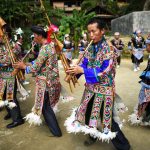Miao

The Miao are a diverse people group scattered throughout the southern mountains of China. Their diversity is reflected in the many alternative names they may be known by, including Hmong, A-Hmao, and Hmu, among others. This people group is unique in that a few Miao subgroups have been touch by the gospel, with many coming to faith. However, the vast majority of Maio subgroups are still very unreached, meriting their inclusion on the Priority 31 list.
The Miao are a celebratory people. Their most popular festival is the Lusheng Festival. Music abounds as men march the roads playing the lusheng, a bamboo flutelike instrument. Miao peoples are usually multilingual and are expert farmers and craftsman. Miao women are known for their colorful embroidery, made with painstaking effort at detail and complexity. Miao villages have become some of the cleanest in China after decades of suffering from malaria outbreaks.
Yet, millions of the Miao people still suffer. Rituals are performed to appease unknown spirits—sometimes at great expense (multiple oxen can be slaughtered when seeking cure from illness). Their traditional belief is that they have three souls. When one dies, one soul goes to the “other world”, one remains in the grave, and the last dwells in the family’s home as a means of protection from evil.
So while there are many Miao believers, these Christians only exist among a few subgroups. The remaining Miao groups are spread over remote, mountainous locations with no access to the Gospel. Groups like the Liupanshui, the Mashan, the Luobohe, and many others still do not have a single believer in any of their villages.


